Today’s SaaS app marketplaces offer customers sophisticated tools to extend the capabilities of SaaS platforms that would take years to build in-house. But with so many apps to choose from customers are spoilt for choice.
That’s why the success of your app in a SaaS marketplace depends on effective optimization. With the right optimization in place, you’ll boost your app’s visibility, increase installs, lower user acquisition costs, and sustain continuous growth with increased app revenue.
This guide will walk you through best practice tips to help your app to stand out against the competition. By the end of this article, you’ll have a clearer idea of how to optimize your app for marketplaces like monday.com. For now though, let’s dive into the basics by looking at why app optimization is so important.
Start buildingThe importance of app optimization in SaaS marketplaces
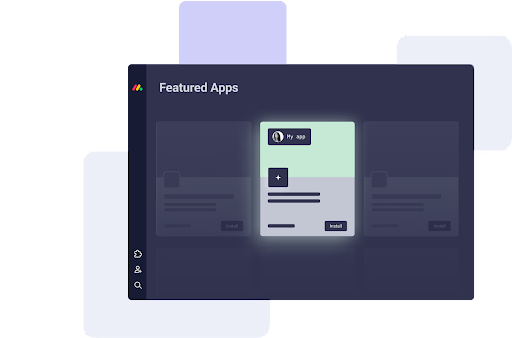
When customers visit a SaaS app marketplace, they’re typically on a mission to solve a problem. They’ve likely hit a wall with their current platform and seeking an app that fills that gap or eliminates a barrier.
That’s why the most successful marketplace apps aren’t necessarily from the biggest brand names, but rather from developers who zero-in on solving common issues. These apps address the demand for efficient, effective solutions and make work-life easier and smoother. So, while brand recognition can be great, it takes a backseat to functionality and problem-solving ability in the world of SaaS app marketplaces.
Now, for developers, this means SaaS marketplaces can be a highly competitive arena. And the buying process for customers is complex too. Customers need to discover your app on the store, look at its key features, benefits, and ratings, and then after onboarding and purchasing a subscription.
All the way through this process, you are competing for each customer’s attention with all the other apps in the marketplace. And if you are new to creating an app, you will have the added struggle of needing to create brand recognition.
From the customer’s point of view, they want to:
- Buy in a simplified way that they are already familiar with
- Have a buying process they already know
- Know how to cancel and express dissatisfaction
This is where app optimization comes in. Simply put, app optimization helps you stand out. It also increases visibility and conversion rates. In effect, without optimization, your app’s ranking and visibility are at the mercy of luck.
App optimization also helps you understand how customers use the app, which allows you to tweak and enhance the app in future releases. All of which help increase revenue. So where do you start? The first step is to understand your customers inside-out. Let’s explore this further in the next section. Or if you’re ready, you can take a look at monday.com’s developer site now.
Start buildingKnow your customers: the key to app success
Getting to grips with your audience will help you to deliver the best possible app experience. And a good place to start is to conduct audience research to understand your target users.
Some neat ways to do your homework on potential customers include:
- User surveys and interviews: Conduct interviews with users to discover their pain points and find what they like about your app and what they like and dislike about competitors. Surveys and micro surveys can help gather insight into what convinces them to buy a product.
- Leverage insight from marketplaces: Some marketplaces, like monday.com, offer insight on their users. For instance, on monday.com you can find inspiration for app ideas, understand pain points, and common use cases.
- Making sense of the numbers: If you already have an app, you can leverage app analytics to find out more about your users. Go through your data and look for common demographics your target customers share. Consider your user’s goals, challenges, questions, and considerations.
- Spot market trends: Look for which apps are trending and compare app ideas with competitors. Also, check out those that receive the most ratings.
- Conduct research across the customer journey: Research is best done at different stages of the user journey, such as during onboarding, cancellation, and customer interaction to obtain a fully rounded picture of how the app is performing.
- Use ratings: This helps understand the real pain points users are dealing with. Search for the top apps in the marketplace and analyze their 2-star, 3-star, and 4-star ratings reviews. This helps to identify questions they are repeatedly asking or problems they’re pointing out.
- Consume relevant content: Find your niche publications and subscribe to them. Also, listen to podcasts and YouTube in your niche. And use social media research to gather raw data from users regarding their pain points.
In summary, conducting audience research helps you understand your users’ goals, challenges, questions, and problems and allows your app to solve these problems. You can then use the data you’ve gathered above to formulate the problems your app solves and position your app as the best solution. More on this next.
The art of app listings: 4 key steps
App listings are a crucial aspect of app development as they provide potential users with a first impression of the app and its features. A well-crafted app listing can attract users and increase installs, while a poorly written one can turn users away. With this in mind, let’s jump right in and explore the art of app listings:
1. Do your research
Research is crucial for your app name, title, description, and other fields. To get started, you will need to make a list of topics or keywords relevant to your app based on your audience research findings. Then consider what customers might search the marketplace for. For example, your app might be focused on ‘forms’ or ‘documents’.
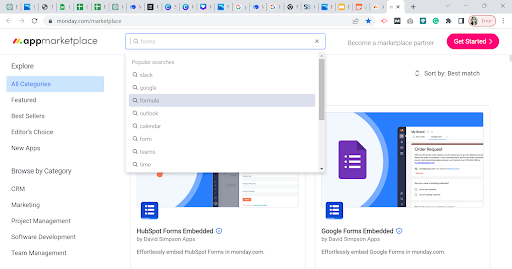
(You can see popular searches on monday.com’s app marketplace search bar)
Next up, analyze the competition. You can use your chosen focus area to find competitors and analyze their listings. We also recommend reviewing your competitor’s websites and looking at how they articulate their solution, including features and benefits.
2. Use a succinct name, title, and subtitles
When it comes to creating a name for your app, it’s a good idea to make sure it has a direct link to what the app does. For example, ‘mandatory fields’, ‘Tableau connector’, and ‘VLOOKUP’. Use the relevant keywords which link to what your app does in the app name title, plus reflect the app’s value and differentiation, to gain an advantage in being found first.
Any keywords placed in the title should be the ones your customers are most likely to use to search for apps, so take some time getting this right as it will be difficult to change this as your app ranks higher and word spreads about its success. Also, take note of any character restrictions.
And as a final check, do some basic customer research and find out if what you have chosen is reflective of their search terms and look at your competitors to see how you compare.
3. Craft a compelling description and use high-quality visuals/screenshots
In today’s marketplace where competition is fierce, creating compelling app descriptions with high quality visuals is crucial to attract and retain users. A well crafted description can persuade users to install your app, enhance the user experience, and increase sales.
Essentially, this is the place to educate and set expectations. It’s your chance to explain to customers what the app really does. Otherwise, you might create a beautiful compelling page, but if it won’t reflect and explain what the app actually does, the user will install, but may be disappointed and could churn.
This isn’t an easy task so here are some pointers to help you craft that persuasive description:
- Make it clear, concise, and communicate the app’s value and key benefits.
- Include your researched keywords.
- Add use cases so it will be clear how the app can help them.
- Bring to life your unique features and benefits. But don’t mislead.
- Make it easily scannable with bullet points and subheaders.
- Describe the problems the app solves.
- Use high quality visuals and screenshots. These will directly impact the click through and install rates.
- Add a video, it’s the first thing users are looking for, to understand what it does – this doesn’t need to be an animated video, but you could use the app UI to explain the benefits and main capabilities.
Top tip: Look at the marketplace’s best sellers and top rated apps to see how they craft their descriptions. VLOOKUP Auto-link is one good example. And SuperForm has a great video example.
4. Use the right categories
Using the right categories can increase app discoverability by making it easier for potential users to find your app through relevant search results and related categories. So choose a category that best describes your app’s main function or subject matter of your app.
Choosing the right category can also increase its visibility to users who may not have been searching for it specifically.
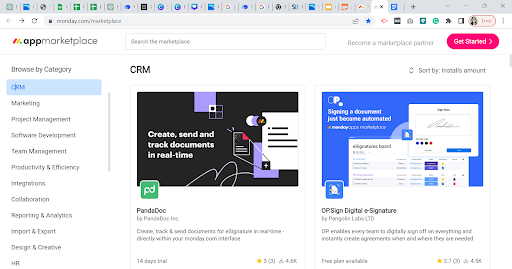
(monday.com has a wealth of categories to choose from)
User experience: The secret sauce of app success
It goes without saying that at the get-go you should create a user-centered design based on your customer research. That way your app will instantly add value because you have already optimized its performance and competitive advantage.
So let’s take a look at some best practice tips:
- Use the right onboarding strategy: Choose the most appropriate strategy when designing your app’s onboarding experience. Consider your user and their journey, so they can see value as quickly as possible. Use tool tips, welcome screens, and checklists to guide users through the in-app onboarding system.
- Keep it simple: Keep your onboarding as brief as possible as you have limited screen space and user attention spans. To do this, we recommend that you create an onboarding that’s informative but concise.
- Give clear instructions: Provide explicit instructions to guide users through the onboarding process.
- Personalize it: Customize the onboarding experience based on the user’s preferences, behavior, and interests gained from your research, with a simple and intuitive user interface.
- Test and retest: Finally, you need to test and then iterate to constantly improve the experience.
With all these tips in place, you can really deliver the “wow” factor in user experience and deliver an app that goes beyond user expectations and requirements. This will leave the user hooked by your app’s features, support, or other aspects, making it likely they will give good ratings and recommend your product.
A helping hand: putting support front and center
In the competitive world of SaaS marketplace app development, providing standout customer support is absolutely crucial. It not only serves to differentiate your offering from the rest but also significantly contributes to client satisfaction and long-term customer loyalty. Excellent customer support begins with a proactive approach.
By ensuring that customer support is integrated into the very fabric of the app’s development and operation, you can truly stand out.
Top tips to put support front and center
Self service support:
- Customers value products that let them help themselves. So provide in-app FAQs and other self-service options to help users resolve issues in their own time.
- Provide clear documentation, including user guides, and troubleshooting guides.
Responsive communication channels:
- Always be there when users need you. For instance, provide multiple channels for users to reach out, such as in-app messaging, support tickets, live chat, and email.
- Provide email support for more complex issues that users can’t resolve on their own.
- Respond to user inquiries as quickly as possible. Use auto-replies to let users know their query has been received and follow up as soon as possible afterward.
Timely and proactive support:
- Go the extra mile and follow up with users the next day with an update, new idea, or helpful suggestion beyond the initial problem.
- It’s also worth analyzing the queries users are making and adding to the FAQs page on an ongoing basis. This will help you identify areas for improvement and take action.
Additional support resources:
- To help customers self-service, you could also include videos and webinars walking customers through potential challenges they may have.
- In addition, tutorial videos and step-by-step guides are incredibly beneficial. These resources visually guide users through specific processes or features within your app.
To sum up, the right support empowers users, provides quick solutions, and reduces the burden on your support team. It’s a win-win situation for both the users and the app developers. However, the key to effective self-service support is to ensure these resources are easy to find, user-friendly, and up-to-date. This way, users can truly benefit from them and have a positive experience with your app.
Why regular updates are your friend
Regular updates and improvements are vital for the success of any SaaS app. With rapidly evolving technology and customer expectations, updates help keep the app relevant, secure, and competitive. Moreover, updates often introduce new features or refine existing ones to enhance the user experience, thereby increasing customer satisfaction and loyalty.
Constant improvements also send a clear message to users that the developers are actively investing in the app’s continuous growth and are committed to delivering a product that meets their needs and expectations. But managing updates efficiently requires a well-structured process.
Here’s three important steps to follow:
Prioritize fixes
One of the crucial steps is prioritizing which features or bug fixes should be tackled first. This decision should be based on a variety of factors, including user feedback, usage data, and strategic business objectives. For instance, if a significant number of users are encountering a specific bug, addressing that issue should take precedence.
Regularly scheduled updates
A consistent release schedule helps in managing updates. Regularly scheduled updates also give users something to look forward to and provides a predictable timeline for when their feedback or reported issues will be addressed.
Incorporate feedback
Incorporating user feedback into updates is a powerful way to ensure that the app continues to meet the needs of its users. An open line of communication, such as surveys, feedback forms, or even direct conversations, can facilitate this. But it’s important to not only gather this feedback but also analyze and act upon it. When users see their feedback being taken into account, they feel valued and heard, which can significantly enhance their affinity for the app.
The magic of positive ratings
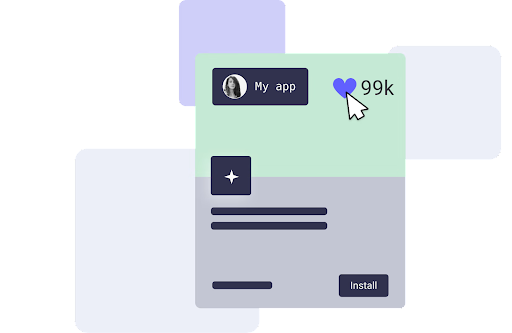
Like with regular updates, great ratings can send your app rocketing to success. Users trust apps with positive ratings, plus they are a ranking signal for the marketplace and the more installs your app receives, the higher the perceived demand and the higher the organic ranking.
And if you have other marketing channels, it’s important you drive people to the marketplace to maximize performance. With this in mind, let’s take a look at some of the ways you can encourage users to rate and review your app:
Ways to encourage users to rate and review:
- Educate your audience: Before asking for ratings and reviews, educate your audience about how important it is for your business. Tell them a review can help build trust and grow your business.
- Ask satisfied customers: When making the ask, target satisfied customers.
- Personalize the ask: Use your customer’s name and mention the app they installed or subscribed to.
- Respond to feedback: Respond to feedback, whether it’s positive or negative, and show that you value your user’s experience and opinions which helps build trust.
On the flip side, dealing with poor app ratings and reviews can be challenging but essential to maintain a positive reputation and build trust with users.
Here are some tips for dealing with poor app ratings and reviews:
- Acknowledge: One of the most powerful ways is to acknowledge the validity of the user’s concerns.
- Respond: Use a gentle, polite, and positive tone. Don’t get defensive or aggressive. Thank the user for their help, admit your mistakes, respond in detail, and thank them.
- Increase trust: By showing you are willing to listen and improve when things aren’t working.
- Work with users: Work with negative reviewers to solve their problems. Once you’ve solved their problems you can ask them if they would amend their rating or review.
- Personalize: Avoid short answers without apologies. Personalize your response and show empathy.
Wondering how this works on monday.com? Here’s a few final pointers to encourage users to rate and review with monday.com:
- One of the best ways is to prompt users to rate your app through a custom URL. Once created, you can then send users this URL so that people can quickly and easily rate you with a few clicks. The URL will send users to your app with the rating modal open and they can then easily rate and review without needing to manually open the app marketplace. Once you’ve created the URL, you can embed it in emails, etc.
- You can also prompt users to rate the app using a one-time pop-up that appears when the user opens the Installed Apps page.
- What’s great about every monday.com review is that it includes the reviewer’s account information. This allows you to personally reach out and address any issues that may have come up.
- Lastly, we’ve put some safeguards in place at monday.com to keep ratings fair. A single negative review won’t unfairly impact an app’s rating since we display the average score. Additionally, a minimum of three reviews are needed before the average score becomes visible.
Unlocking app success with app optimization
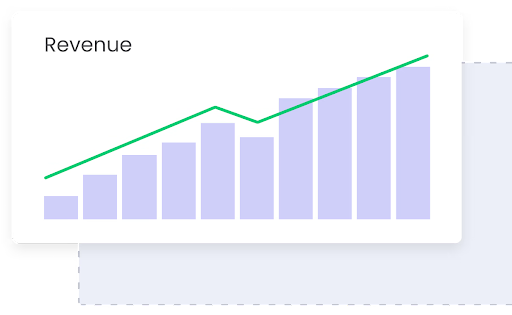
To rise above the competition, optimization is your secret weapon. Through effective optimization, you’ll transform your app into a powerful tool that attracts attention, drives installs, reduces costs, and fuels continuous growth.
You’ll also enhance user engagement, satisfaction, and the overall experience. As we’ve just seen, understanding your audience is crucial to this. It all starts by diving deep into audience research to uncover their goals, challenges, and pain points, and then tailoring your listing to meet those needs.
Plus, by using an onboarding experience that showcases the value of your app quickly and concisely you can deliver the “wow factor”. Finally, regular updates demonstrate commitment, improve app performance, and increase user satisfaction. All of this leads to great ratings which can propel your app to success.
By implementing these powerful strategies, you’ll unlock new levels of visibility, engagement, and revenue growth. If you are ready to take the leap and optimize your app for success in the monday app marketplace, you can start here.
Looking for more?
Take a look at some further reading on SaaS marketplace apps here:
- How to build a SaaS marketplace app: 6 steps to revenue-generation
- SaaS app analytics guide: tools, tips, and metrics to track
- A marketplace app success story: VLOOKUP Auto-link

